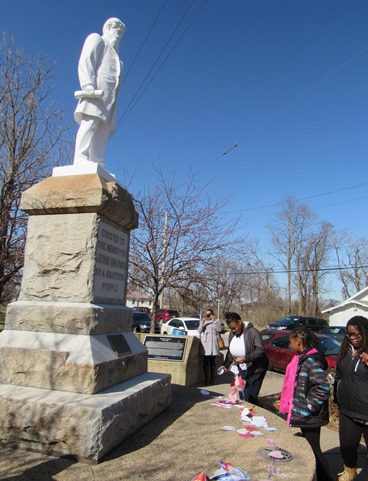
by Mary Rupert
Kansas City, Kansas, delivered a powerful answer to hate and intolerance on Wednesday afternoon at the John Brown statue at 27th and Sewell.
The event was a commemoration of the life and work of Dr. Martin Luther King Jr, marking the 50th anniversary of Dr. King’s death on April 4. It was a community event with several groups participating. The program also was an answer to the vandalism with hate slurs discovered March 18 at the John Brown statue.
Students placed garlands around the John Brown statue, which was vandalized last month. The statue honors Brown, who was an abolitionist in pre-Civil War days. Students for KCK Values participated in the program Wednesday, with help from teachers, and from the staff from the Boys and Girls Club. More than 100 persons attended the program.
The vandalism at the John Brown statue was noted by speakers at the program Wednesday.
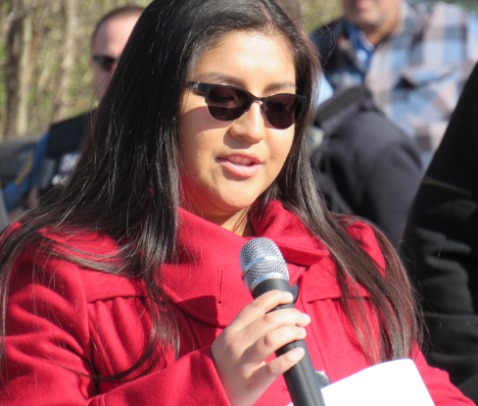
Megan Dorantes, a junior at Sumner Academy, said anger starts to build up inside of people who encounter injustices.
“But instead of starting riots, and destroying property, I got involved,” Dorantes said. “Martin Luther King impacted my life by teaching me that instead of taking out my emotions through violence, I should rather share them in a peaceful manner. The minute you revert to violence is the minute that people no longer understand you and listen to you. Without him and the civil rights movement, I wouldn’t be able to stand here today and give you this speech.
“We may think that the civil rights movement is finished, but we know that it’s far from over,” she said.
Incidents such as those involving the death of Michael Brown and the vandalism of the John Brown statue are examples that the fight for equality and against racism is far from over, she said.
“To those who vandalized John Brown’s statue: I’m sorry that you’re afraid of me,” she said. “I do think that diversity is a threat to you, that vandalizing this statue and tearing apart this community by creating fear is how you want to be known and remembered. But guess who is showing their face today. Guess who is not afraid. We are not afraid.”
“Hatred is a lonely place to be, but love welcomes a community,” she said.
Education and getting involved will solve the problems of racism and injustices, she said.
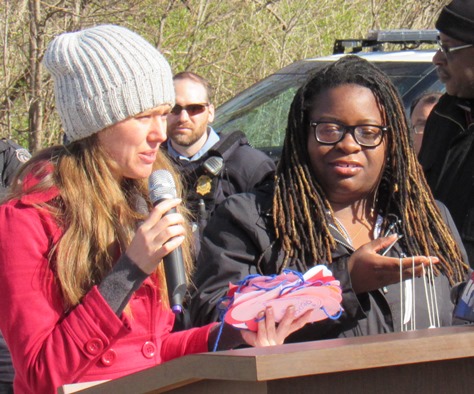
Tamra Miller with Sumner Academy said students there wanted to make a visual statement in response to the vandalism of the John Brown statue. Students created hearts on a garland with messages such as “seek joy” and “we rise together.” Educator Shanette Dinkins and graphic design students at Wyandotte High School also participated with discussions and making a garland.
One resident who attended the event, Christine Allen, said she felt that it was a good tribute to the past.
“The future is on its way, we must keep our values up and have grace and dignity,” she said.
Public officials also spoke at the program.
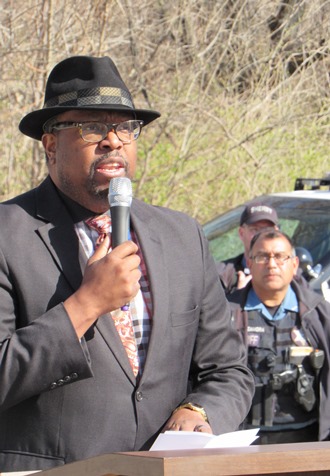
“We also stand here today united against those who would for no good reason defame this monument,” Unified Government Commissioner Harold Johnson said, after remembering Dr. Martin Luther King Jr. “While it is reprehensible what happened to this memorial, it should not shock us as we are still polarized as a nation and a society, particularly as it relates to racism and inequality.”
Johnson remarked that John Brown said in his last speech in Charleston, West Virginia, that his intent was simply to free slaves, never intending to murder or make insurrection. He quoted Brown’s statement that his interference on behalf of the despised poor was not wrong, but right. Brown concluded that now, if it was necessary for him to forfeit his life for the means of justice, “so let it be done.”
Johnson also quoted Dr. King’s statement that the nation must undergo a radical shift of values, changing from a theme-oriented society to a person-oriented society.
Johnson quoted Dr. King as saying, when machines and computers and profit motives and property rights are considered more important than people, the giant triplets of racism, extreme materialism and militarism are incapable of being conquered.
Dr. King’s words, though spoken over 50 years ago, are still prophetic, Johnson said.
“Let us not fool ourselves, my brothers and sisters, there are still forces, even within our community, who allow evil to dictate their motivations,” Johnson said. “Those who would stoop so low as to deface this monument of hope, such as this John Brown memorial, we can look to history as our guide, because we can see even 50 years ago there were those who sought to silence Dr. King. They stood against his position of nonviolent civil discord. Even during this season of Easter, we are reminded of those who defamed the personhood of Christ. So while those moments in time served as a stain on the consciousness of our community, our beloved community, those heinous moments did not and must not cause the efforts of righteousness and equity to cease and desist.”
In fact, those moments in many ways served as a commitment for the next phase for the struggle for what was right for the whole of society, he said.
“Let us continue to fight for the resurrection of our community,” Johnson said. “Let us continue to fight for the resurrection of our neighborhoods, let us continue to fight for the resurrection of the hope that lies within all of us to make this community a better place to live, a better place to grow up, a better place that we call home.”
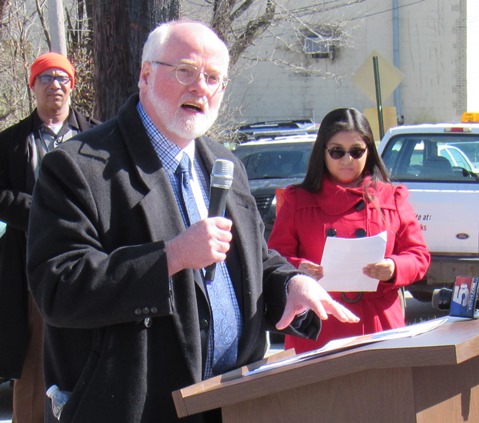
Mayor David Alvey spoke about Dr. King’s vision.
“When we honor Martin Luther King, we honor his vision of what America was meant to be, and what it can be, in fact, what it must be,” Mayor Alvey said at the program.
“We honor his vision that he did not create on his own, but he learned that vision from his God, and his God who created all of us and who desired as he placed us in the garden, that all of us, each one of us should enjoy the fruits of God’s creation and continue to create good things for all to enjoy, and not to withhold from one another the good that God meant for all,” Mayor Alvey said. “We come to celebrate Martin Luther King for his commitment, his devotion, his desire that God placed in his heart.”
“I want to say to the children, the young people, take your time to learn about Dr. King,” Mayor Alvey said. “Take your time to learn about the vision that he saw. Take your time to learn and pay attention to the ways in which we have deprived one another of what God has desired to give us. And commit yourself to bring that vision to fruition for all because that is the way to peace, that is the way to glory, that is the way to justice.”
“The struggle is not over,” Mayor Alvey said. “There are still those who would come and defile someone who represents all that is true and noble in our country, and at the same time there are those who would defile this statue, there are those who cannot stand by to watch it and will step up to do something.”

Alvey recognized Officer Dennis Vallejo of the Kansas City, Kansas, Police Department, who volunteered to clean the statue after it was vandalized.
Commissioner Johnson also read a statement from Commissioner Gayle Townsend: “Let us focus on the fact that acts of discrimination, intolerance and hate, all of which Dr. King vehemently opposed, will never last, and will never outlast or be overshadowed by acts of love, peace, justice and equality,” Commissioner Townsend’s statement read. “Be confident in the fact that acts of cowardice and intolerance and hate will be crushed and erased, just like the despicable marks on the statue, by people of good will like you, who have all gathered together today to remember this immortal drum major for justice.”
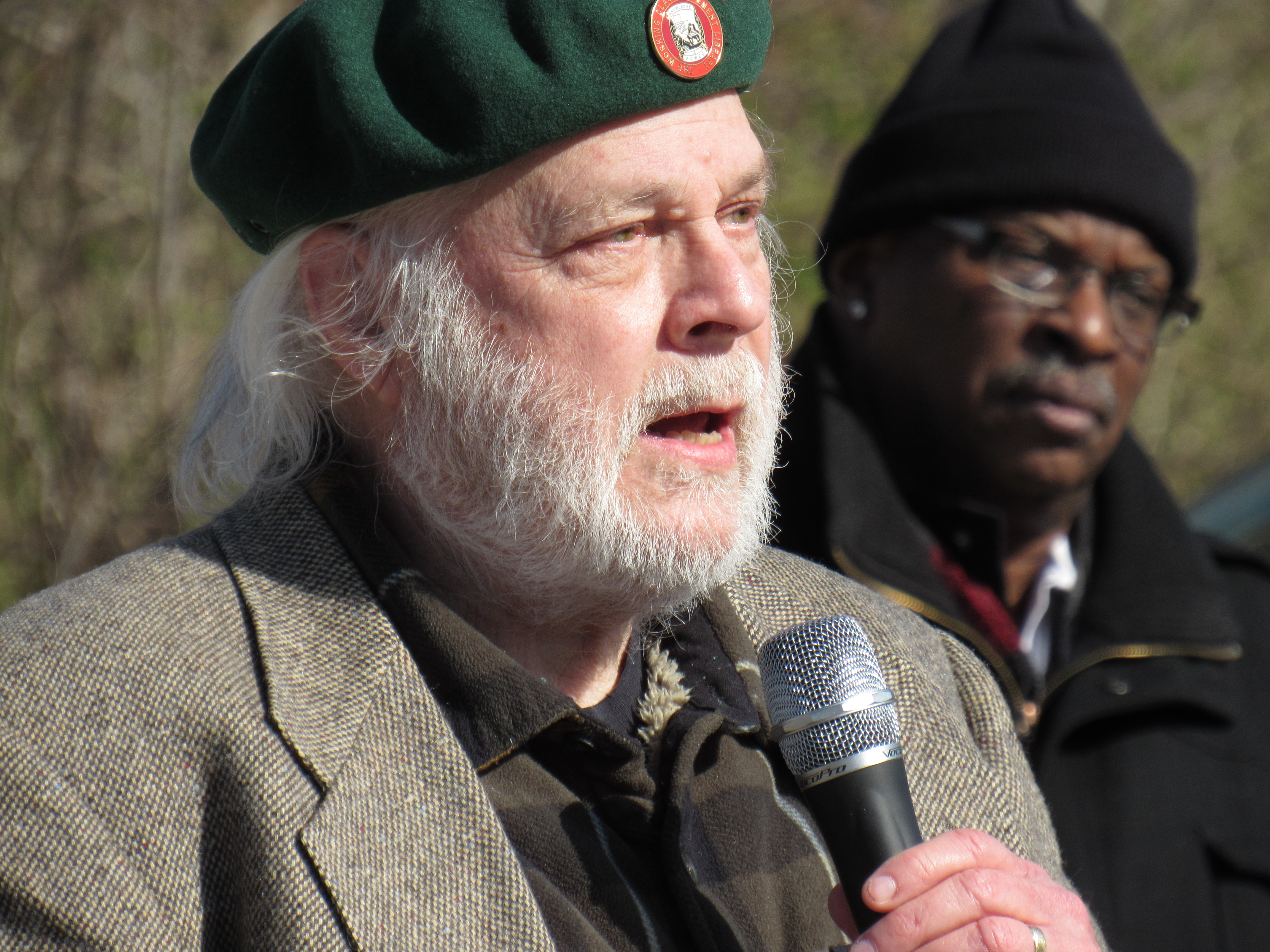
Also as part of the program, Dr. Fred Whitehead gave a brief speech about the history involving the John Brown statue.
In 1910, a segregationist was elected mayor of Kansas City, Kansas, and in response, the African-American community raised funds to erect a statue of abolitionist John Brown, Whitehead said. African Methodist Episcopal Church members collected nickels, dimes and quarters to pay for the statue.
In 1910, Western University was in the Quindaro area near 27th and Sewell, and when the statue was unveiled in 1911, thousands of people attended the ceremony, he said.
Whitehead mentioned Officer Vallejo’s efforts to clean the statue after the vandalism March 18 of this year, as well as former Mayor Joe Reardon’s role in restoring the monument several years ago.
“We will never forget, never abandon it,” Dr. Whitehead said.
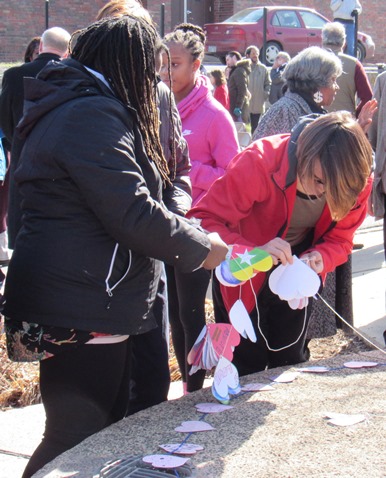





Many thanks for this fine, detailed report on our event, the best one published so far.
What a wonderful uplifting story! I wish I could have been there.
And thank you, Fred, and all others for this report. It is so important for so many of us – in every community. I appreciate it. And I’m certain appreciation will grow throughout the years.
just plain terrific. And for all who attended, may I recommend a fabulous brilliant an entertaining collection of short stories by National Book Award winner Charles Johnson: Dr. King’s Refrigerator and Other Bedtime Stories. The spirit in this book and the gifts of grace are so great I wish to share them with as many people as possible. Thanks. Ernie Brill.